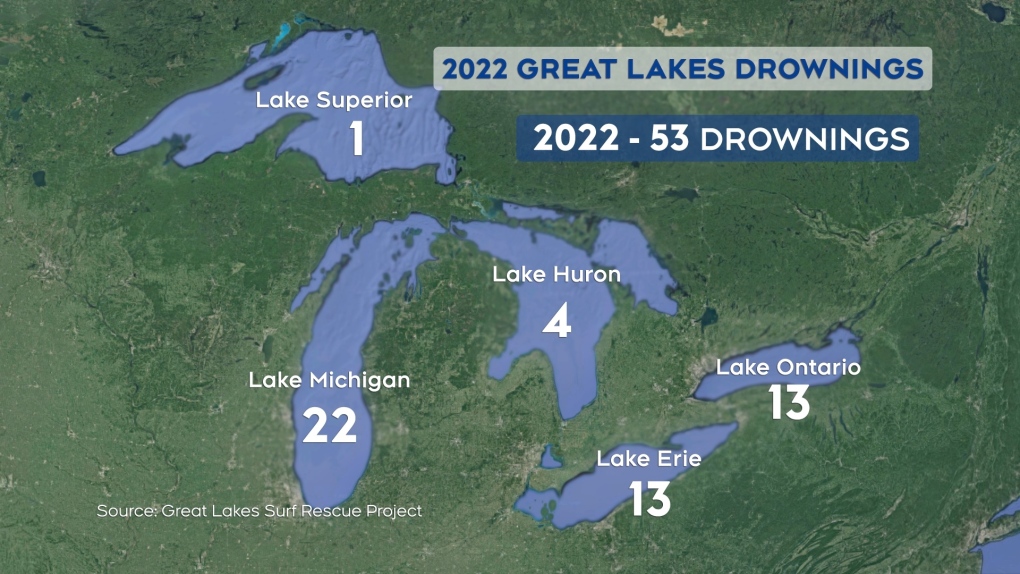Great Lakes drownings climb to 50+ this year, experts warn of rip currents
A group of researchers studying the dangers of rip currents are putting a spotlight on beach safety as drownings in the Great Lakes climb above fifty this year.
“Drownings are becoming an emerging public health issue,” says Chris Houser, dean of University of Windsor’s science faculty and head of the Coastal Research Group.
To date in 2022, there have been 53 drownings on the Great Lakes, according to statistics from the Great Lakes Surf Rescue Project.
Rip currents are strong and localized blasts of water that move directly away from the shore.
Houser explains water that appears to be calm can be deceiving.
“Rip currents or are caused by waves breaking. If you see calm water between two areas of waves breaking, the water might look calm, but that is actually where the current is developed,” said Houser.
His team’s research has found that even when warning signs are posted, many beachgoers fail to notice them or misinterpret the signs.
“Beach safety cannot be achieved through passive means. It requires accurate and dynamic warnings as well as an investment in lifesaving technology and lifeguards,” said Houser.
The City of Windsor is facing a lifeguard shortage that is expected to stretch into 2023.
“We generally carry between 175 to 200 aquatic staff year-round. Right now, our staffing complement is sitting at around 140 to 150,” explained Jen Knights, City of Windsor’s executive director of recreation and culture.
Knights says the lifeguard shortage combined with a drop in demand has led to the city’s aquatic programs operating at reduced levels this season.
 The number of drownings in the Great Lakes in 2022. (Source: Great Lakes Surf Rescue Project)
The number of drownings in the Great Lakes in 2022. (Source: Great Lakes Surf Rescue Project)
CTVNews.ca Top Stories

Loonie falls to lowest since 2020 after Trump threatens tariffs on Canadian goods
The Canadian dollar fell to its lowest level since May 2020 after Donald Trump threatened to impose tariffs on Canadian goods shipped to the United States once he takes office in January.
They thought they'd found Amelia Earhart's plane. Instead, the search continues
The disappearance of pioneering aviator Amelia Earhart more than 87 years ago has remained one of the most captivating mysteries in history, with a handful of explorers devoted to scouring the seas for any clue to her final whereabouts.
DEVELOPING Follow live: Notorious killer Paul Bernardo seeks parole
Paul Bernardo, one of Canada’s most notorious killers, is seeking parole at the medium security La Macaza Institution in Quebec. He was transferred there from an Ontario maximum-security prison last year, to significant public outcry.
Longtime member of Edmonton theatre community dies during 'A Christmas Carol' performance
Edmonton's theatre community is in mourning after an actor died during a performance of "A Christmas Carol" at the Citadel Theatre on Sunday.
DEVELOPING Trudeau confirms premiers meeting, Poilievre calls Trump tariff threat 'unjustified'
Prime Minister Justin Trudeau will be convening a meeting of all of Canada's premiers 'this week' to discuss U.S. president-elect Donald Trump's intent to impose a 25 per cent tariff on all products from Canada and Mexico on his first day in office, if border issues aren't addressed.
South Korea convicts man over binge eating to dodge military draft
A South Korean man who ate to the point of obesity in an attempt to dodge the army has avoided prison after he pledged to take up his mandatory military service.
Ontario woman buys van with odometer rolled back almost 100,000 kilometres
An Ontario woman thought she got a good deal when she bought a van for $2,700, but later learned the odometer had been rolled back nearly 100,000 kilometres.
Video shows B.C. cat bursting through pet door to confront raccoons
Several hungry raccoons were chased off a B.C. couple’s deck this week by one over-confident house cat – who was ultimately lucky to saunter away unscathed.
Netanyahu recommends his Cabinet approve a Hezbollah ceasefire proposal
Israeli Prime Minister Benjamin Netanyahu has announced he will recommend a proposal for a cease-fire with Hezbollah to his Cabinet for approval, setting the stage for an end to nearly 14 months of fighting.

































